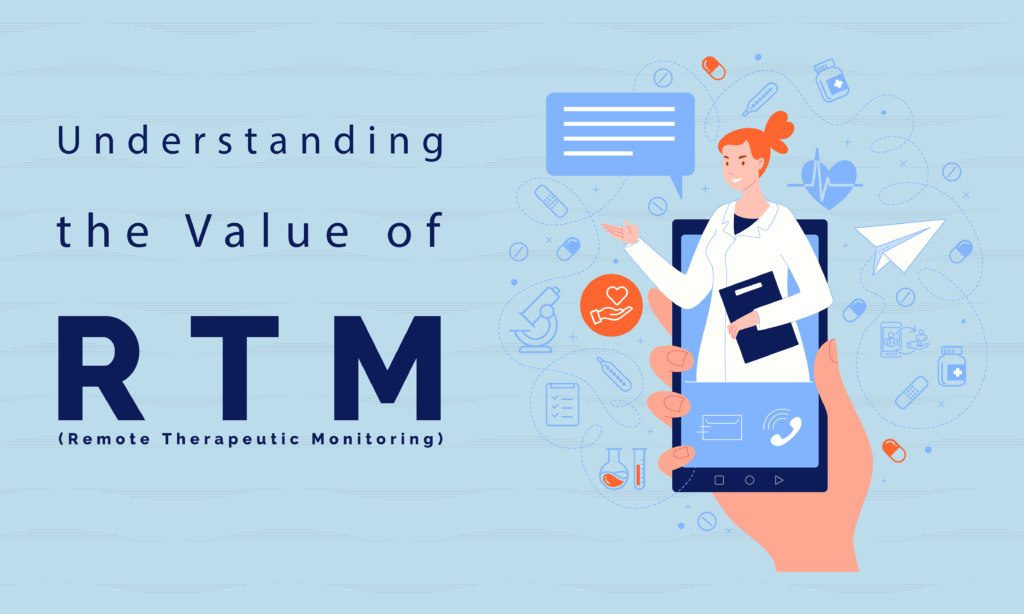Virtual healthcare is innovating care delivery making it accessible for many, particularly underserved patient populations, and reducing costs for all stakeholders. Medicare acknowledged this innovation when it approved the reimbursements for Remote Therapeutic Monitoring early this year. This newest addition further cements the value of telehealth in providing affordable and timely care.
Remote Therapeutic Monitoring (RTM) pushes the bar higher because it enables providers to have greater oversight of patients through the use of self-reported data. Patients are able to report when and how they take their medications, what treatments they are getting, and even what they are feeling, which makes the tool highly useful for other telehealth services like managing mental health and chronic conditions.
So what is RTM? What makes it a valuable preventive tool?
Understanding the Basics
Remote Therapeutic Monitoring (RTM) is a healthcare service to monitor health conditions by collecting non-physiological data like pain levels, medication adherence, and therapy adherence. It is designed to manage patients who are using medical devices to automatically collect and report patient data to the clinical team.
It is similar to a complementary service, Remote Patient Monitoring (RPM), but they differ in important ways like in the type of data they collect.
RPM itself is fairly new with Medicare introducing the program in 2019. This healthcare service captures physiological data in contrast with RTM’s non-physiologic therapeutic data. The RPM data is automatically transmitted in near real-time to the clinical team for review so timely adjustments to the trajectory of care can be done.
The patient data includes vital signs (pulse rate, weight, blood pressure, and blood glucose levels). By taking these readings, clinicians will be able to gauge if the patient is following their care plan and managing their care well.
Meanwhile, RTM data can be subjective and may also be quantitative. When clinicians have access to RTM data, they will have a more comprehensive evaluation of the patient’s health status and determine a more effective and timely delivery of care.
The Benefits of RTM
The self-reporting data that RTM captures offer clinicians a good look into patients’ behavior. It opens doors for more virtual care services like virtual physical therapy, pain management, respiratory care, closer diabetes management, and more.
RTM provides valuable benefits to patients, providers, and the entire healthcare system. It improves many aspects of care such as:
1. Higher quality of care
Providers can now closely monitor their patients in-between office visits so they can effectively deliver care when it is needed the most.
2. Better patient outcomes
Because RTM provides greater oversight, patients will be able to experience more positive outcomes. More importantly, they can avoid costly hospitalization or an unscheduled ER visit.
3. Improved patient engagement
Patients can now easily and swiftly obtain feedback on how they manage their care. For instance, patients can be guided on the proper technique in completing an exercise. In this way, they become more confident and engaged in doing their tasks with better and more accurate results.
4. Greater access to care
With shortages in doctors, telehealth services like RTM can now expand to communities with limited access to healthcare.
5. Reduced financial burden
The overall cost savings for RTM is expected to be $6.4 billion annually thereby relieving an already burdened healthcare system. Moreover, practices that offer RTM can also increase their bottom line with new RTM billable codes.
CMS guidelines on RTM
With RTM, more healthcare professionals can participate in Medicare’s reimbursement programs because RTM codes are categorized under general medicine.
So who can bill for RTM? They are the following:
- Physicians
- Practitioners
- Physician assistants
- Licensed clinical social workers
- Nutrition professionals
- Physical therapists
- Occupational therapists
- Psychologists
- And more
In its introduction in 2022, RTM only allowed healthcare providers to bill for remote patient management for patients with respiratory and musculoskeletal conditions based on the medical devices that collect non-physiologic data. New changes have been recently implemented that also cover the physical therapy and home fitness programs often prescribed by rehabilitation therapists. Providers are now getting paid when they engage with the patient to monitor, guide, and push for adherence in between therapy sessions.
Usually, payers and providers often take a wait-and-see stance before adopting recently released new codes by CMS. For most, they will need about 6 to 12 months to ascertain how others are faring with the new codes. With RTM, there is already a precedent in 2019 with RPM codes. Moreover, RTM codes are designed with the ongoing goal of creating incentives for providers to keep pace with the new age of telehealth, post-COVID time. The newest codes fill in the gap in reimbursements that were left empty in the first version of the codes. RPM has paved the way in attesting the value of telehealth in delivering effective and timely care.
The Future of Telehealth
CMS also proposed new 2023 CPT codes for analyzing therapeutic data through RTM and virtual patient engagement tools and techniques. These will offer providers additional revenue streams while increasing the potential for more positive health outcomes. The recent code changes in remote care management in 2022 and the proposed changes in 2023 are creating new avenues to innovate care delivery, particularly in-between appointments.
For sure, telehealth is a care delivery innovation that will stay and continue to improve. It leans on its greatest asset, which is to facilitate a fast and easy connection between the provider and the patient. Though not a replacement for face-to-face or in-office care, providers and patients understand the benefits virtual care offers particularly in continuing the care and expanding its access.



